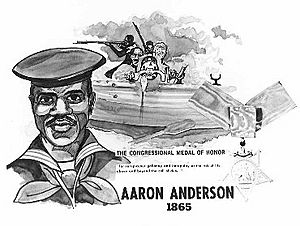Aaron Anderson (Medal of Honor) facts for kids
Quick facts for kids
Aaron Anderson (Sanderson)
|
|
|---|---|

A U.S. Navy poster from 1970 featuring Anderson
|
|
| Born | 1811 Rogers, Arkansas, U.S. |
| Died | January 9, 1886 (aged 74–75) Philadelphia, Pennsylvania, U.S. |
| Buried | |
| Allegiance | |
| Service/ |
|
| Years of service | 1863–1865 |
| Rank | Landsman |
| Unit | USS Wyandank |
| Battles/wars | American Civil War |
| Awards | Medal of Honor |
Aaron Anderson or Sanderson (born 1811 – died January 9, 1886) was a brave sailor in the Union Navy during the American Civil War. He was the first Black American to receive the Medal of Honor. This is America's highest award for military bravery.
Anderson was born in Arkansas. He later moved to Pennsylvania. There he worked as a cook. At 52 years old, he joined the Navy. He served on a ship called the USS Wyandank. His job was to help stop Confederate forces from getting supplies. This happened along the Potomac River.
Near the end of the war, Anderson took part in a dangerous mission. They attacked Confederate troops trying to get supplies. During the fight, their boats were badly damaged. Many weapons were also destroyed. For his brave actions, he received the Medal of Honor. After his time in the Navy, not much is known about his life.
Contents
Aaron Anderson was born on a farm in Rogers, Arkansas. He was a Black American. When he was a young man, he moved to Philadelphia, Pennsylvania. Before joining the Navy, he worked as a cook.
On April 17, 1863, at age 52, he joined the U.S. Navy. He was given the rank of landsman. This was a sailor who did general duties. He was assigned to the ship USS Wyandank. However, his last name was accidentally written as "Sanderson" in the ship's records.
The Wyandank was part of the Potomac River Flotilla. This was a group of ships. Their job was to enforce a blockade. This blockade stopped Confederate ships from using the Potomac River. It was important for the Union side.
Brave Actions in the Civil War
The Mattox Creek Mission
On March 17, 1865, the war was almost over. Aaron Anderson took part in a mission. They went to attack Confederate forces. This happened in Mattox Creek, in Virginia. This creek flowed into the Potomac River.
A special boat was used for the mission. It had a small cannon called a howitzer. This boat was launched from another ship, the USS Don. A group of seventy soldiers also went on foot. They walked along the river bank.
Anderson and other Black landsmen rowed the boat. Boatswain's Mate Patrick Mullen operated the howitzer. Ensign Summers was in charge. As the boat and soldiers moved up the creek, snipers fired at the soldiers. They found four small Confederate boats. The soldiers on land destroyed them.
Facing Heavy Fire
The boat then rowed back down the creek. They went up the left fork. Without soldiers on land, the boat was in danger. Confederate soldiers on the banks could attack them. The left fork also had deeper water. This meant they might meet bigger enemy boats.
As they rounded a bend, they saw three schooners. These were large sailing ships. They seemed empty. Mullen got ready to fire the howitzer at them. Suddenly, about 400 Confederate soldiers on shore opened fire.
Ensign Summers ordered Anderson and the other rowers to go towards the schooners. When they were close enough, Mullen threw special fire devices onto each ship. The schooners caught fire.
Escape and Recognition
With the enemy ships burning, the boat started to retreat. They faced heavy fire from the Confederates. Half of the boat's oars were destroyed. Summers' musket was also hit. The boat had several bullet holes.
Anderson and the men who still had oars kept rowing. The other rowers bailed water out of the damaged boat. Mullen fired the howitzer at the soldiers on shore. They successfully escaped the Confederate force. The boat was badly damaged. But only one landsman was slightly hurt.
Ensign Summers praised Anderson and Mullen for their bravery. Both men received the Medal of Honor on June 22, 1865. Anderson's award was given under the name "Aaron Sanderson." This was the misspelling from the Wyandank's records. Mullen later earned a second Medal of Honor. This made him one of only nineteen people to receive it twice.
Later Life and Passing
Aaron Anderson left the U.S. Navy after his service ended. Not much is known about his life right after the war. However, if his real name was Sanderson, he returned to Philadelphia. He lived and worked in South Philadelphia.
City records from that time show he had many jobs. He worked as a laborer, cook, and whitewasher. He was also a coachman. An Aaron Sanderson, described as a Black widower, died on January 9, 1886. He was seventy years old. He worked as a "calciminer," which is another word for whitewasher. He lived at 1357 Kater Street in South Philadelphia. He died of heart disease. He was buried four days later at the former Lebanon Cemetery.
Images for kids


